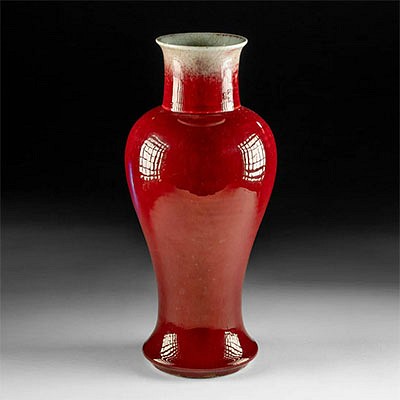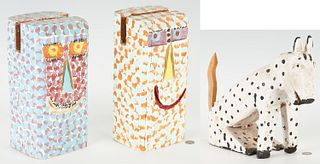Rare Olmec Palette / Mirror, Toad-Shaman Form
Lot 194
About Seller
Artemis Gallery
686 S Taylor Ave, Ste 106
Louisville, CO 80027
United States
Selling antiquities, ancient and ethnographic art online since 1993, Artemis Gallery specializes in Classical Antiquities (Egyptian, Greek, Roman, Near Eastern), Asian, Pre-Columbian, African / Tribal / Oceanographic art. Our extensive inventory includes pottery, stone, metal, wood, glass and textil...Read more
Estimate:
$5,000 - $7,500
Absentee vs Live bid
Two ways to bid:
- Leave a max absentee bid and the platform will bid on your behalf up to your maximum bid during the live auction.
- Bid live during the auction and your bids will be submitted real-time to the auctioneer.
Bid Increments
| Price | Bid Increment |
|---|---|
| $0 | $25 |
| $300 | $50 |
| $1,000 | $100 |
| $2,000 | $250 |
| $5,000 | $500 |
| $10,000 | $1,000 |
| $20,000 | $2,500 |
| $50,000 | $5,000 |
| $100,000 | $10,000 |
| $200,000 | $20,000 |
About Auction
By Artemis Gallery
May 11, 2023
Set Reminder
2023-05-11 10:00:00
2023-05-11 10:00:00
America/New_York
Bidsquare
Bidsquare : Fine Antiquities, Asian, Pre-Columbian, Ethnographic Art
https://www.bidsquare.com/auctions/artemis-gallery/fine-antiquities-asian-pre-columbian-ethnographic-art-12771
Classical antiquities, ancient and ethnographic art from cultures encompassing the globe. Artemis Gallery info@artemisgallery.com
Classical antiquities, ancient and ethnographic art from cultures encompassing the globe. Artemis Gallery info@artemisgallery.com
- Lot Description
**Originally Listed At $3000**
Pre-Columbian, Southern Mexico / Guatemala, Olmec, ca. 1150 to 500 BCE. An incredibly rare earthenware amphibian creature with hematite eyes, the body inlaid with a flat greenstone that may have been a palette, and the other side is inlaid with a rough limestone. We highly suspect that the stomach was used as a mirror based on research and museum collections - pyrite and anthracite were often used as mirrors in Pre-Columbian cultures, and limestone, which this tested as, is a common host for pyrite veins. The greenstone palette surface was perhaps for mixing cosmetics or face paint. The molded pottery holding these stones in place, has slender limbs tucked into the sides like a crouching frog / toad, although the face is quite anthropomorphic, and perhaps symbolizes a human to animal transformation. Size: 6" L x 4.5" W x 2" H (15.2 cm x 11.4 cm x 5.1 cm); 6.5" H (16.5 cm) on included custom stand.
Mirrors were prized by the ancients of the Americas and believed to serve as portals to the celestial realm, treasured for their divinatory, healing, as well as decorative properties. Obsidian mirrors are well known in Pre-Columbian cultures, but other stones containing iron ore were also used. Pyrite was one such mineral, however due to the high iron content which rusts and corrodes, and the reflective surface of these mirrors often do not survive. Interestingly eyes were strongly connected with mirrors and deities and rulers, those important enough to have access to mirrors, were sometimes depicted with mirrors or obsidian for eyes. Scenes on painted vessels also depict important people gazing into mirrors, often held by attendants.
In Mesoamerica, people would have heard the chorus of frogs and toads as rain arrived - indeed, to the Maya, frogs are known as the musicians of the rain god Chaac. The hallucinogenic secretions of the largest Mesoamerican toad, Bufo marinus, were likely used by the Olmec in religious rituals involving transformation, and we know that these toads were used by the later Maya too. These amphibians were associated with fertility and regeneration.
PLEASE NOTE: Due to recent increases of shipments being seized by Australian & German customs (even for items with pre-UNESCO provenance), we will no longer ship most antiquities and ancient Chinese art to Australia & Germany. For categories of items that are acceptable to ship to Australia or Germany, please contact us directly or work with your local customs brokerage firm.
Provenance: private Hawaii collection, acquired 2000 to 2010
All items legal to buy/sell under U.S. Statute covering cultural patrimony Code 2600, CHAPTER 14, and are guaranteed to be as described or your money back.
A Certificate of Authenticity will accompany all winning bids.
We ship worldwide and handle all shipping in-house for your convenience.
#177434Professionally restored and repaired. New material and infill to rim surrounding the flat, polished stone. Stone is repaired with faint break line radiating from lower left side. New material added to verso of head. Restoration with new material to rear legs. Stable fissure on front arms. Missing reflective mirror, with remains of stone imbedded in stomach area as shown. Great preservation to the face and stone eyes.Condition
- Shipping Info
-
All shipping is handled in-house for your convenience. Your invoice from Artemis Gallery will include shipping calculation instructions. If in doubt, please inquire BEFORE bidding for estimated shipping costs for individual items. In most cases Artemis Gallery cannot ship to Australia and Germany, please inquire before bidding.
-
- Buyer's Premium



 EUR
EUR CAD
CAD AUD
AUD GBP
GBP MXN
MXN HKD
HKD CNY
CNY MYR
MYR SEK
SEK SGD
SGD CHF
CHF THB
THB














